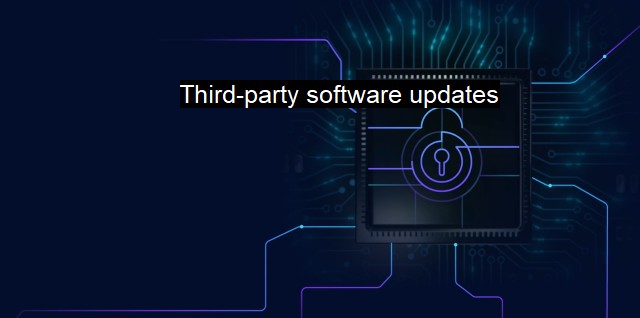What are Third-party software updates?
The Importance of Third-Party Software Updates for Data Security in Today's Business Landscape: A Focus on Patching and Antivirus Operations
Third-party software updates, with refer to updates issued by an entity other than the manufacturer of the software. They are commonly implemented when the software product is part of an integrated whole or is interfacing with other software products from different producers. This independent entity may either be the actual developer who outsourced manufacturing or an entirely different software manufacturer whose product interfaces with the original manufacturer's product.In managing cybersecurity, parties do not solely concentrate on their operating systems or primary software. It also entails micro-focus on other little software products that link to the original applications. Apps like plug-ins, extensions, add-ons, and even third-party apps installed in the original software are part of the system treated with emphasis. These components or apps often require their updates separate from the main software or app, hence the need for third-party software updates.
Updates are necessary as often as they are required to keep software abreast of recent developments, improve performance, fix bugs, eradicate vulnerabilities, or simplify usage. This explains why updates are a consistent part of any software or application. because most third-party software works within the confines of another extensive software, the method for updating such software may not be structured or as automated as the original software.
This area is where the primary problem with third-party software update lies — many users don’t take them seriously. Unlike the auto-update feature in most standard software, for many third-party software, users need to manually trigger the update process. It's easier for users to click away pop-ups for updates and then kick-start a potential security risk, negating any of the antivirus software benefits that might be protecting your system. Thinking about the “do-it-later” sentiments to updates is one of the many potential security risks that opens up while using third-party software.
When these third-party plugins, extensions, or even the ardent updates themselves become outdated, they unfortunately can become security risks since they can form easy targets for cybercriminals. Unfortunately, these third-party software items often don’t have excellent security measures in place, making them more susceptible to cyber-attacks. They could be exploited as pathways for entry into the broader system, obliterating the efforts of cybersecurity frameworks or antivirus software in place.
Cybercriminals have been known to target third-party software specifically, mainly because of the relatively lax security measures associated with such programs. By exploiting these weak links, attackers can access more critical systems and execute manifold malicious activities effectively. Thus, from a cybersecurity standpoint, third-party software updates can sometimes present more vulnerabilities than the problems they aim to alleviate.
If well factored into the software user's cybersecurity strategy, third-party software updates can also contribute to robust software security for users. An updated third-party software item stands to gain solidification of its codes or functions against hackers and can protect proprietary information from leaking. It can counter vulnerabilities and provide better shields for the main software, given that the product has navigable access in the original software pathway.
Third-party software updates, if correctly managed, can become a reputable bulwark ensuring software security, enforcing antivirus principles and lending more authority over security processes. The third-party software update isn't an independent function; it enhances cybersecurity when incorporated as part of the continuum. As increasing third-party software will interplay with those of other manufacturers, the need for effective third-party software update management would remain an essential constant within the realm of cybersecurity and antivirus solutions.

Third-party software updates FAQs
What are third-party software updates?
Third-party software updates refer to updates released by software vendors other than the manufacturer of an operating system. These updates are crucial for keeping software programs secure and up-to-date.Why are third-party software updates important for cybersecurity?
Third-party software updates are important for cybersecurity because they often contain security patches that address vulnerabilities in the software. Keeping software programs up-to-date with the latest security patches can help prevent cyber attacks targeting those vulnerabilities.How can I ensure that third-party software updates are installed on my computer?
You can ensure that third-party software updates are installed on your computer by enabling automatic updates in the software program's settings or by using a third-party patch management tool. It is important to regularly check for updates and install them promptly to maintain the security of your computer.What risks are there when using third-party software updates?
There are risks associated with using third-party software updates, such as downloading updates from unauthorized sources or installing updates that contain malicious code. To mitigate these risks, it is important to only download updates from trusted sources and to thoroughly research any software updates before installing them.| | A | | | B | | | C | | | D | | | E | | | F | | | G | | | H | | | I | | | J | | | K | | | L | | | M | |
| | N | | | O | | | P | | | Q | | | R | | | S | | | T | | | U | | | V | | | W | | | X | | | Y | | | Z | |
| | 1 | | | 2 | | | 3 | | | 4 | | | 7 | | | 8 | | |||||||